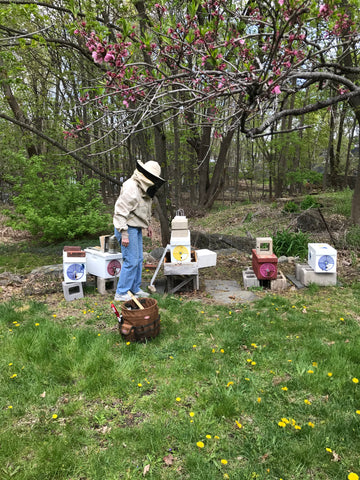THE SUNDAY SCOOP 05/02/21: Hive Work at the Interfaith Garden!
Today’s partly sunny weather and warm temperatures made it the perfect day to visit the Lexington Interfaith Garden and visit the hives there. Alix recently received ten Italian queen bees and brought all the queens to the session today - some will be introduced to their new colonies! Each queen came in their individual “mini-homes” with some acquaintances as well as a marshmallow-sugar substance inside. Below is a close-up picture of a small box containing a queen and her travelling buddies. You can spot a hive bee saying hello from outside the box!

Bee Club members observed as Alix carefully introduced individual queens to the hives. In general, there is one queen bee in each hive, and she helps reproduce and grow the colony. The five bee hive nucs in the garden previously did not have a queen, but now they do! Below is a picture of a hive welcoming their new queen!

The queen is inside the small light box that is held tightly in-place between two frames of the nuc hive. The nuc’s bees are responsible for releasing the queen from her box and accept her into the colony. Before securing the box holding the queen between the frames, Alix poked a hole through the side of the box so that the queen can easily be introduced to the colony. The marshmallow-sugar substance blocks that opening hole, so it’s the colony’s duty to eat through the substance and form an opening for the queen.
Between introducing each queen to her hive, Alix uses a cool gadget that blows a calming smoke over the bees. This not only calms the bees but also hides any unfamiliar scents that may be present - either from the queen bee or humans (aka Alix and the Bee Club helpers). The smoke is also a reminder for the bees to get back to their beehive work. Here is a picture of Alix blowing some of the smoke onto a closed hive. You can see a cluster of bees on the side of the nuc:
Something Alix also did with the hives was scraping off burr comb, which is the extra chunks of hard honeycomb on top of the nuc frames. Burr combs are often created by bees and are frequently removed by beekeepers because it prevents the hive from closing up properly. If a hive isn’t closed properly, the heat within the hive will easily be lost, and that’s problematic during colder weather. Here is an up-close picture of Alix removing a burr comb:

The overall set-up of introducing the queens was very quick and fun! Alix finished setting up the five hives, which will be used by the Bee Club researchers for their varroa mite project - updates on those are around the corner!

Keep up with our weekly postings of the Sunday Scoop and come back soon!
Written by: Marina Chen
